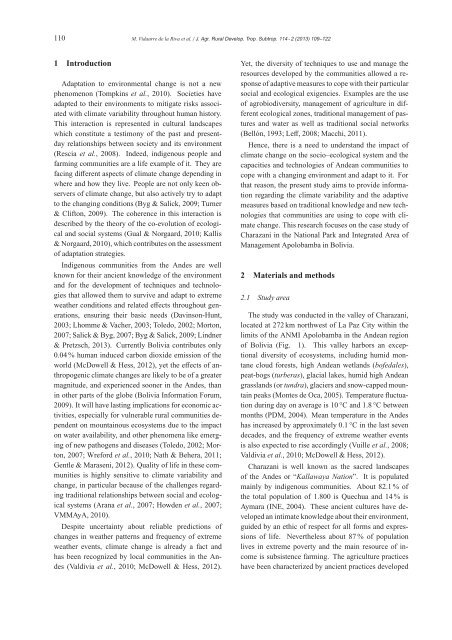Assessing adaptation – Climate change and indigenous ... - KOBRA
Assessing adaptation – Climate change and indigenous ... - KOBRA
Assessing adaptation – Climate change and indigenous ... - KOBRA
You also want an ePaper? Increase the reach of your titles
YUMPU automatically turns print PDFs into web optimized ePapers that Google loves.
110 M. Vidaurre de la Riva et al. / J. Agr. Rural Develop. Trop. Subtrop. 114 - 2 (2013) 109<strong>–</strong>122<br />
1 Introduction<br />
Adaptation to environmental <strong>change</strong> is not a new<br />
phenomenon (Tompkins et al., 2010). Societies have<br />
adapted to their environments to mitigate risks associated<br />
with climate variability throughout human history.<br />
This interaction is represented in cultural l<strong>and</strong>scapes<br />
which constitute a testimony of the past <strong>and</strong> presentday<br />
relationships between society <strong>and</strong> its environment<br />
(Rescia et al., 2008). Indeed, <strong>indigenous</strong> people <strong>and</strong><br />
farming communities are a life example of it. They are<br />
facing different aspects of climate <strong>change</strong> depending in<br />
where <strong>and</strong> how they live. People are not only keen observers<br />
of climate <strong>change</strong>, but also actively try to adapt<br />
to the changing conditions (Byg & Salick, 2009; Turner<br />
& Clifton, 2009). The coherence in this interaction is<br />
described by the theory of the co-evolution of ecological<br />
<strong>and</strong> social systems (Gual & Norgaard, 2010; Kallis<br />
& Norgaard, 2010), which contributes on the assessment<br />
of <strong>adaptation</strong> strategies.<br />
Indigenous communities from the Andes are well<br />
known for their ancient knowledge of the environment<br />
<strong>and</strong> for the development of techniques <strong>and</strong> technologies<br />
that allowed them to survive <strong>and</strong> adapt to extreme<br />
weather conditions <strong>and</strong> related effects throughout generations,<br />
ensuring their basic needs (Davinson-Hunt,<br />
2003; Lhomme & Vacher, 2003; Toledo, 2002; Morton,<br />
2007; Salick & Byg, 2007; Byg & Salick, 2009; Lindner<br />
& Pretzsch, 2013). Currently Bolivia contributes only<br />
0.04 % human induced carbon dioxide emission of the<br />
world (McDowell & Hess, 2012), yet the effects of anthropogenic<br />
climate <strong>change</strong>s are likely to be of a greater<br />
magnitude, <strong>and</strong> experienced sooner in the Andes, than<br />
in other parts of the globe (Bolivia Information Forum,<br />
2009). It will have lasting implications for economic activities,<br />
especially for vulnerable rural communities dependent<br />
on mountainous ecosystems due to the impact<br />
on water availability, <strong>and</strong> other phenomena like emerging<br />
of new pathogens <strong>and</strong> diseases (Toledo, 2002; Morton,<br />
2007; Wreford et al., 2010; Nath & Behera, 2011;<br />
Gentle & Maraseni, 2012). Quality of life in these communities<br />
is highly sensitive to climate variability <strong>and</strong><br />
<strong>change</strong>, in particular because of the challenges regarding<br />
traditional relationships between social <strong>and</strong> ecological<br />
systems (Arana et al., 2007; Howden et al., 2007;<br />
VMMAyA, 2010).<br />
Despite uncertainty about reliable predictions of<br />
<strong>change</strong>s in weather patterns <strong>and</strong> frequency of extreme<br />
weather events, climate <strong>change</strong> is already a fact <strong>and</strong><br />
has been recognized by local communities in the Andes<br />
(Valdivia et al., 2010; McDowell & Hess, 2012).<br />
Yet, the diversity of techniques to use <strong>and</strong> manage the<br />
resources developed by the communities allowed a response<br />
of adaptive measures to cope with their particular<br />
social <strong>and</strong> ecological exigencies. Examples are the use<br />
of agrobiodiversity, management of agriculture in different<br />
ecological zones, traditional management of pastures<br />
<strong>and</strong> water as well as traditional social networks<br />
(Bellón, 1993; Leff, 2008; Macchi, 2011).<br />
Hence, there is a need to underst<strong>and</strong> the impact of<br />
climate <strong>change</strong> on the socio<strong>–</strong>ecological system <strong>and</strong> the<br />
capacities <strong>and</strong> technologies of Andean communities to<br />
cope with a changing environment <strong>and</strong> adapt to it. For<br />
that reason, the present study aims to provide information<br />
regarding the climate variability <strong>and</strong> the adaptive<br />
measures based on traditional knowledge <strong>and</strong> new technologies<br />
that communities are using to cope with climate<br />
<strong>change</strong>. This research focuses on the case study of<br />
Charazani in the National Park <strong>and</strong> Integrated Area of<br />
Management Apolobamba in Bolivia.<br />
2 Materials <strong>and</strong> methods<br />
2.1 Study area<br />
The study was conducted in the valley of Charazani,<br />
located at 272 km northwest of La Paz City within the<br />
limits of the ANMI Apolobamba in the Andean region<br />
of Bolivia (Fig. 1). This valley harbors an exceptional<br />
diversity of ecosystems, including humid montane<br />
cloud forests, high Andean wetl<strong>and</strong>s (bofedales),<br />
peat-bogs (turberas), glacial lakes, humid high Andean<br />
grassl<strong>and</strong>s (or tundra), glaciers <strong>and</strong> snow-capped mountain<br />
peaks (Montes de Oca, 2005). Temperature fluctuation<br />
during day on average is 10 °C <strong>and</strong> 1.8 °C between<br />
months (PDM, 2004). Mean temperature in the Andes<br />
has increased by approximately 0.1 °C in the last seven<br />
decades, <strong>and</strong> the frequency of extreme weather events<br />
is also expected to rise accordingly (Vuille et al., 2008;<br />
Valdivia et al., 2010; McDowell & Hess, 2012).<br />
Charazani is well known as the sacred l<strong>and</strong>scapes<br />
of the Andes or “Kallawaya Nation”. It is populated<br />
mainly by <strong>indigenous</strong> communities. About 82.1 % of<br />
the total population of 1.800 is Quechua <strong>and</strong> 14 % is<br />
Aymara (INE, 2004). These ancient cultures have developed<br />
an intimate knowledge about their environment,<br />
guided by an ethic of respect for all forms <strong>and</strong> expressions<br />
of life. Nevertheless about 87 % of population<br />
lives in extreme poverty <strong>and</strong> the main resource of income<br />
is subsistence farming. The agriculture practices<br />
have been characterized by ancient practices developed















